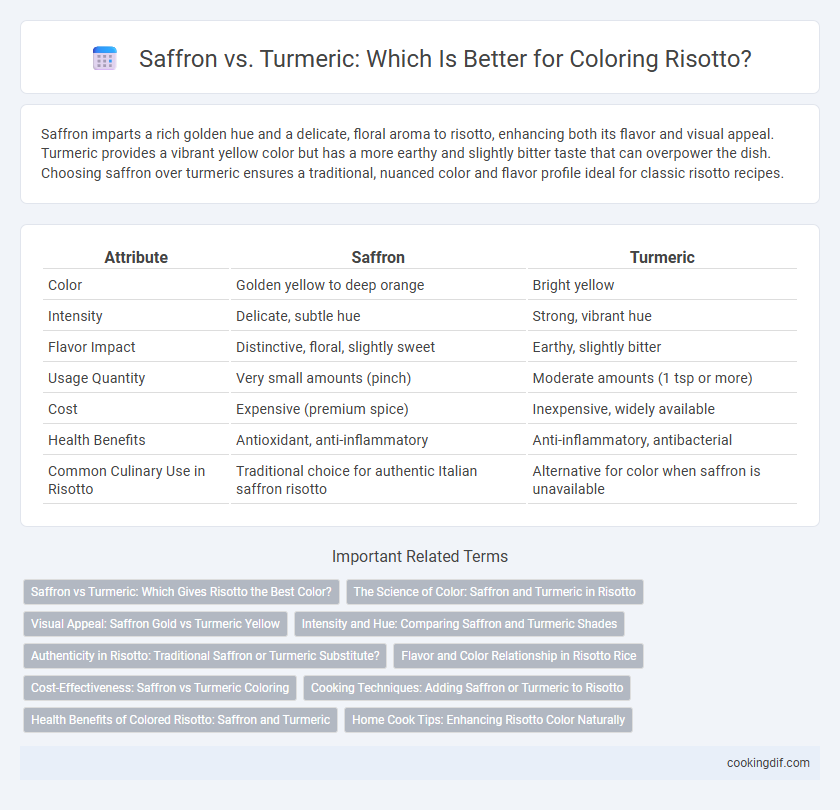Saffron imparts a rich golden hue and a delicate, floral aroma to risotto, enhancing both its flavor and visual appeal. Turmeric provides a vibrant yellow color but has a more earthy and slightly bitter taste that can overpower the dish. Choosing saffron over turmeric ensures a traditional, nuanced color and flavor profile ideal for classic risotto recipes.
Table of Comparison
| Attribute | Saffron | Turmeric |
|---|---|---|
| Color | Golden yellow to deep orange | Bright yellow |
| Intensity | Delicate, subtle hue | Strong, vibrant hue |
| Flavor Impact | Distinctive, floral, slightly sweet | Earthy, slightly bitter |
| Usage Quantity | Very small amounts (pinch) | Moderate amounts (1 tsp or more) |
| Cost | Expensive (premium spice) | Inexpensive, widely available |
| Health Benefits | Antioxidant, anti-inflammatory | Anti-inflammatory, antibacterial |
| Common Culinary Use in Risotto | Traditional choice for authentic Italian saffron risotto | Alternative for color when saffron is unavailable |
Saffron vs Turmeric: Which Gives Risotto the Best Color?
Saffron imparts a vibrant golden-yellow hue and a delicate, aromatic flavor that elevates the visual appeal and authenticity of risotto. Turmeric offers a bright yellow color but can introduce an earthy bitterness that may overpower the dish's subtle taste. For traditional risotto, saffron remains the preferred choice due to its superior color quality and complementary flavor profile.
The Science of Color: Saffron and Turmeric in Risotto
Saffron imparts a vibrant golden-yellow hue to risotto due to its crocin compound, which absorbs light in the visible spectrum, offering both color and a subtle floral aroma. Turmeric contains curcumin, a stable pigment responsible for its bright yellow color, but it can sometimes impart a slightly bitter taste, altering the risotto's flavor profile. The choice between saffron and turmeric not only affects the visual appeal but also the chemical interaction with other ingredients, influencing both color stability and sensory experience.
Visual Appeal: Saffron Gold vs Turmeric Yellow
Saffron imparts a rich, deep golden hue to risotto, creating an elegant and luxurious visual appeal prized in traditional Italian cuisine. Turmeric offers a bright yellow color that is vivid but often less subtle, resulting in a more rustic and earthy presentation. The choice between saffron gold and turmeric yellow significantly influences the dish's aesthetic, with saffron enhancing refinement and turmeric emphasizing vibrancy.
Intensity and Hue: Comparing Saffron and Turmeric Shades
Saffron imparts a rich, golden-yellow hue with an intense, slightly reddish tint that enhances risotto's visual appeal and subtle flavor complexity. Turmeric delivers a vibrant, bright yellow color but tends to create a more matte and less nuanced shade compared to saffron. The intensity of saffron's coloration is more concentrated, making it ideal for dishes that benefit from a deep, luxurious tone, while turmeric provides a bold but flatter yellow ideal for cost-effective coloring.
Authenticity in Risotto: Traditional Saffron or Turmeric Substitute?
Traditional risotto achieves its signature golden hue and delicate aroma from authentic saffron, a prized spice harvested from Crocus sativus stigmas, renowned for its complex flavor and rich color compounds. Turmeric, often used as a cost-effective substitute, imparts a bright yellow color but lacks saffron's subtle floral notes and depth, compromising the dish's traditional authenticity. Culinary experts emphasize that true Milanese risotto relies on saffron to preserve the heritage and sensory profile intrinsic to the classic recipe.
Flavor and Color Relationship in Risotto Rice
Saffron imparts a delicate floral aroma and a rich golden-yellow hue, enhancing both the visual appeal and subtle complexity of risotto rice. Turmeric provides a more earthy and slightly bitter flavor, delivering a vibrant yellow color but lacking the nuanced depth saffron offers. The choice between saffron and turmeric significantly influences the sensory experience, balancing authentic flavor with desired color intensity in risotto.
Cost-Effectiveness: Saffron vs Turmeric Coloring
Turmeric offers a highly cost-effective alternative to saffron for coloring risotto, providing a vibrant yellow hue at a fraction of the price. Saffron, known for its distinctive flavor and aroma, carries a premium cost often exceeding $500 per pound, making it less accessible for budget-conscious cooking. Turmeric delivers a similar visual appeal in risotto while significantly reducing ingredient expenses without replicating saffron's complex taste profile.
Cooking Techniques: Adding Saffron or Turmeric to Risotto
Saffron imparts a delicate floral aroma and a vibrant golden hue to risotto when infused in warm broth before gradual incorporation, ensuring even color distribution and flavor depth. Turmeric offers a more robust earthy color and subtle bitterness, best added directly to the sauteed onions at the start to release its pigments without overwhelming the dish. Precision in timing and quantity of either spice is essential to balance color intensity and preserve risotto's creamy texture.
Health Benefits of Colored Risotto: Saffron and Turmeric
Saffron and turmeric both enhance risotto with vibrant colors while offering distinct health benefits; saffron contains crocin and safranal compounds that promote antioxidant effects and mood improvement, whereas turmeric is rich in curcumin, known for its anti-inflammatory and immune-boosting properties. Incorporating saffron or turmeric into risotto not only adds visual appeal but also delivers phytonutrients that support cardiovascular health and reduce oxidative stress. Choosing between saffron and turmeric depends on desired flavor profiles and specific health advantages, making both spices valuable for nutritious, colorful risotto dishes.
Home Cook Tips: Enhancing Risotto Color Naturally
Saffron imparts a rich golden hue and a delicate floral aroma to risotto, enhancing both color and flavor naturally. Turmeric offers a vibrant yellow color but can introduce a slightly bitter, earthy taste, so use sparingly to avoid overpowering the dish. Home cooks seeking an authentic look and subtle taste should favor saffron for traditional risotto, reserving turmeric as an economical alternative for visual effect.
Saffron vs Turmeric for coloring Infographic

 cookingdif.com
cookingdif.com